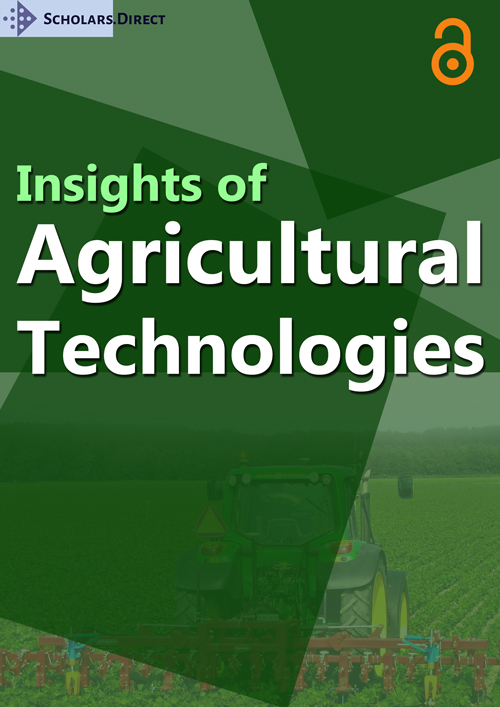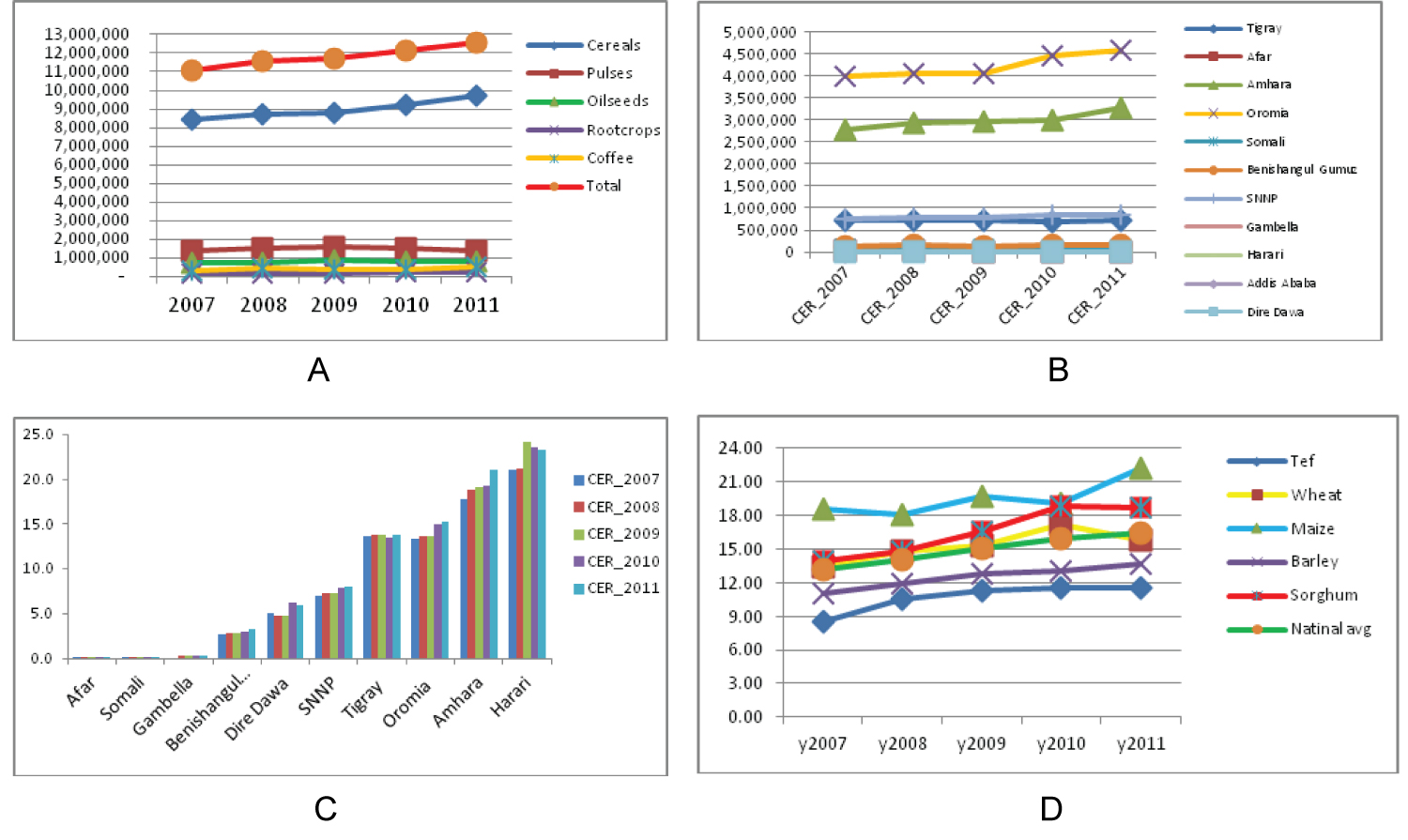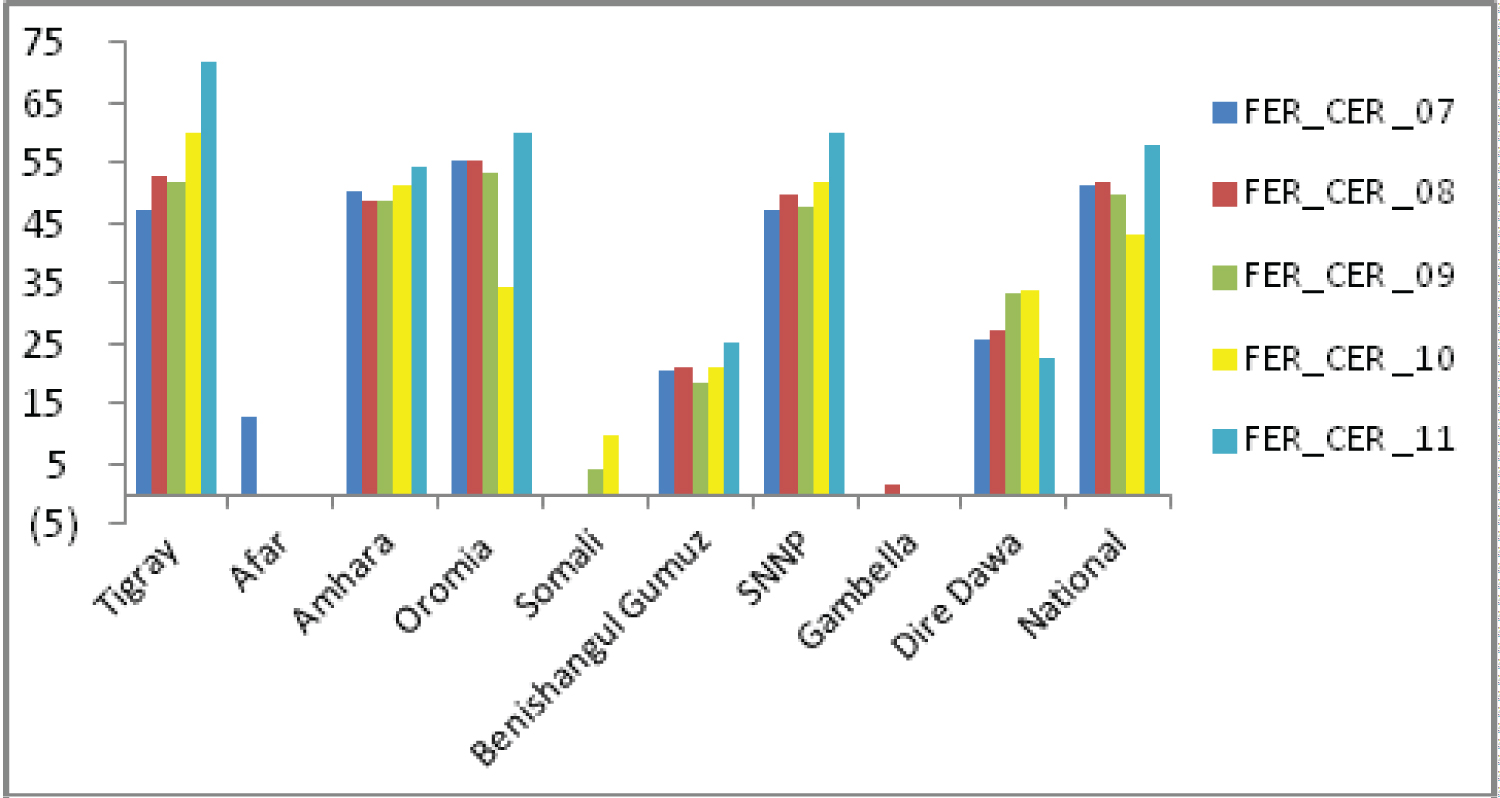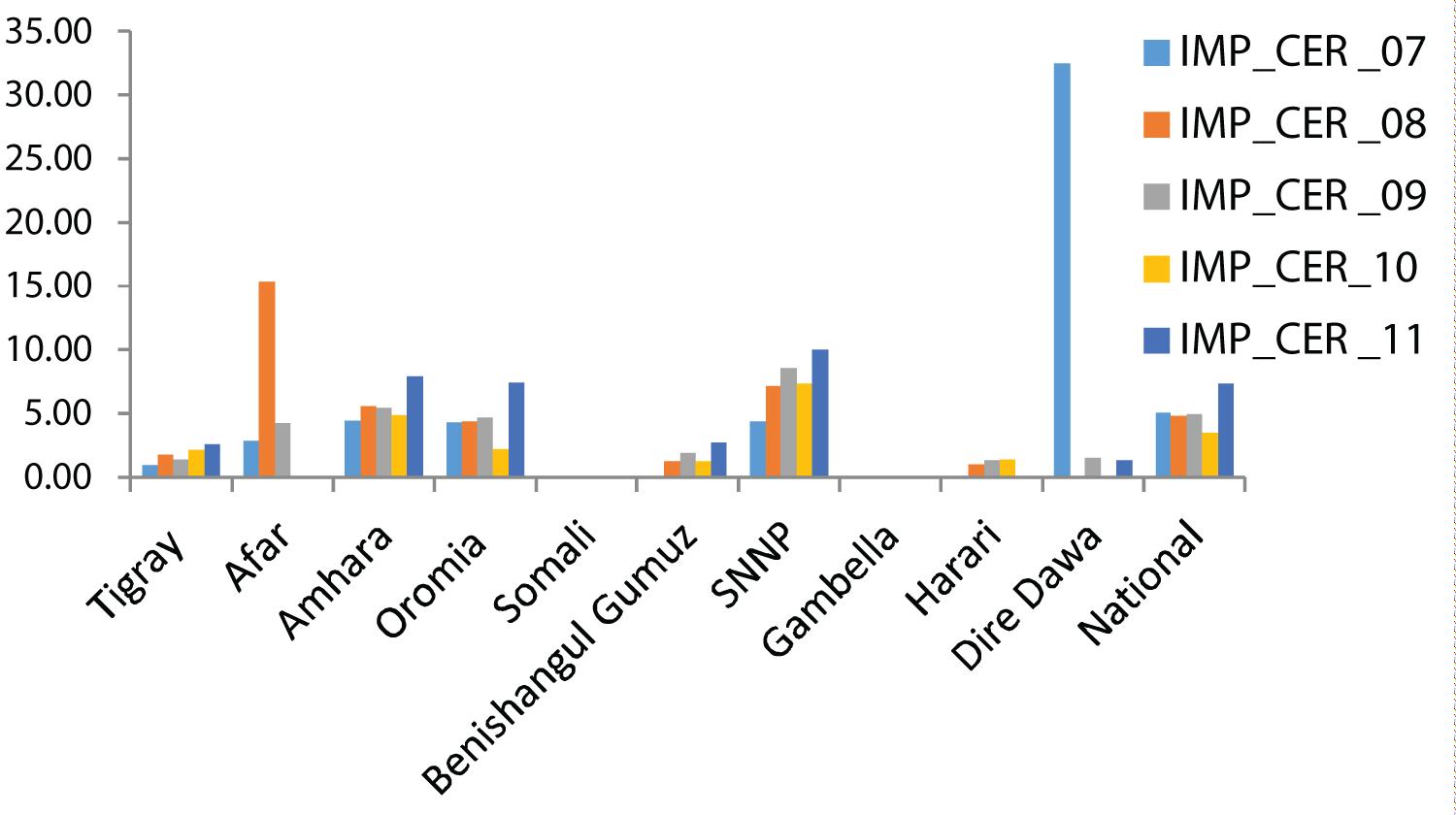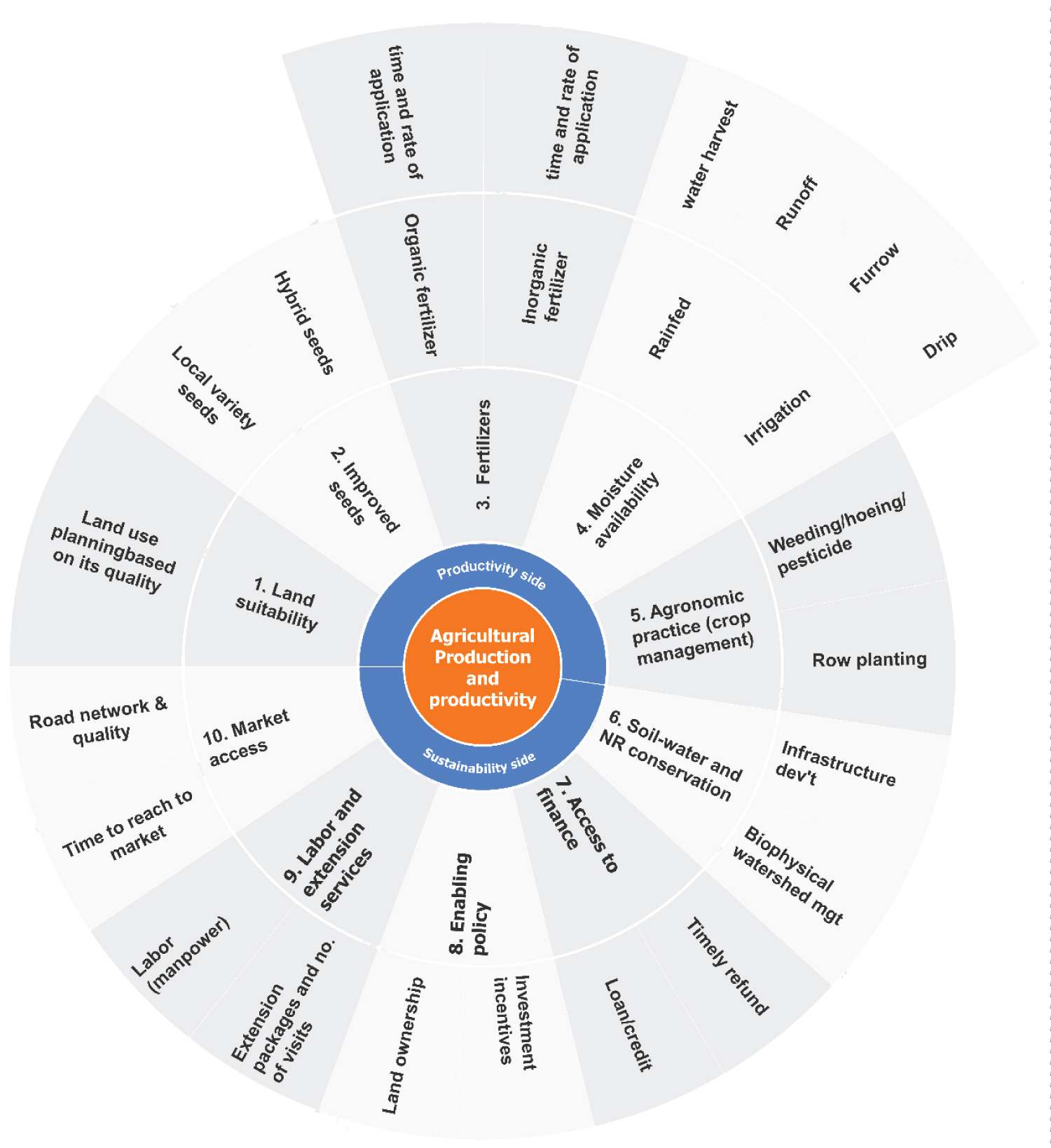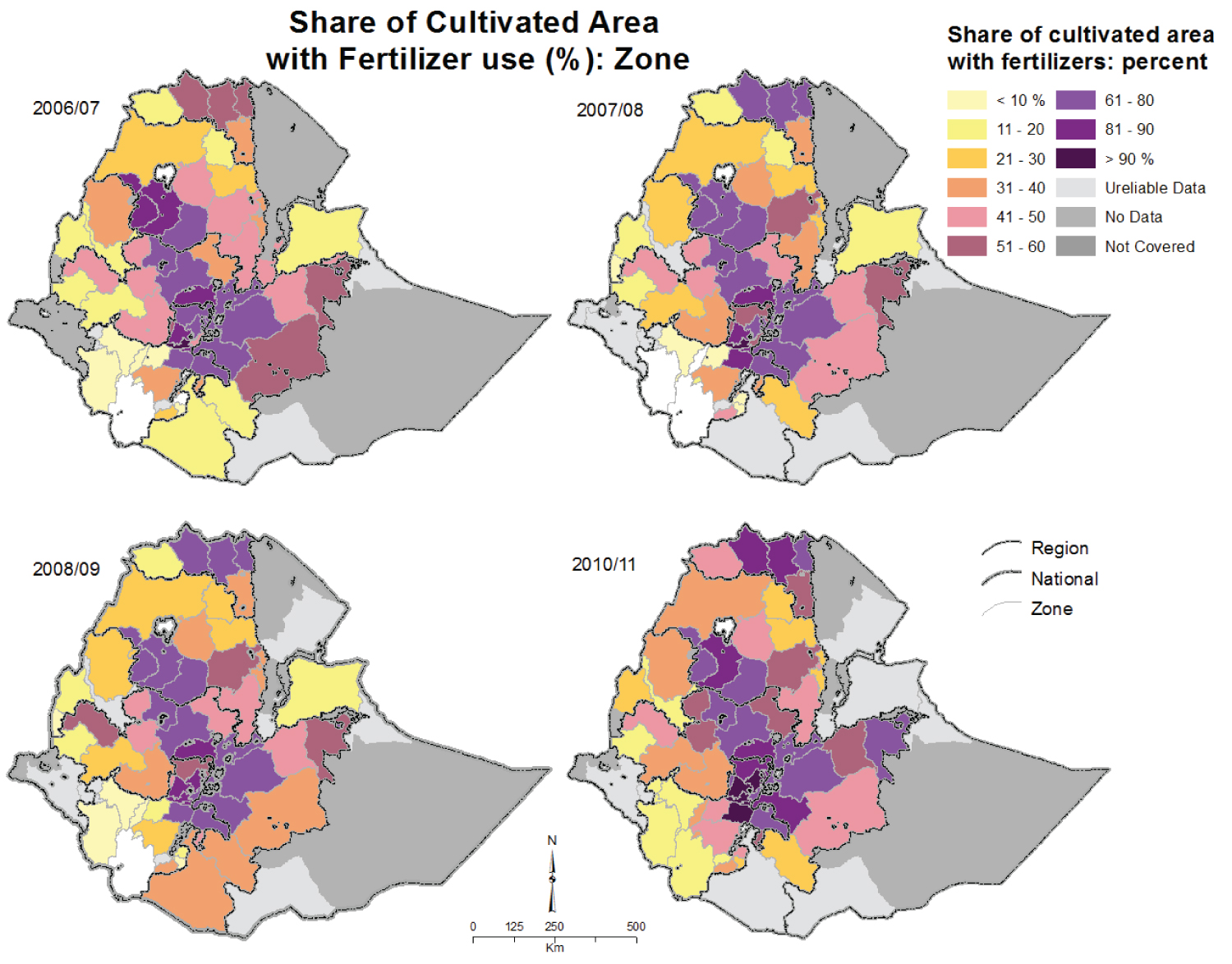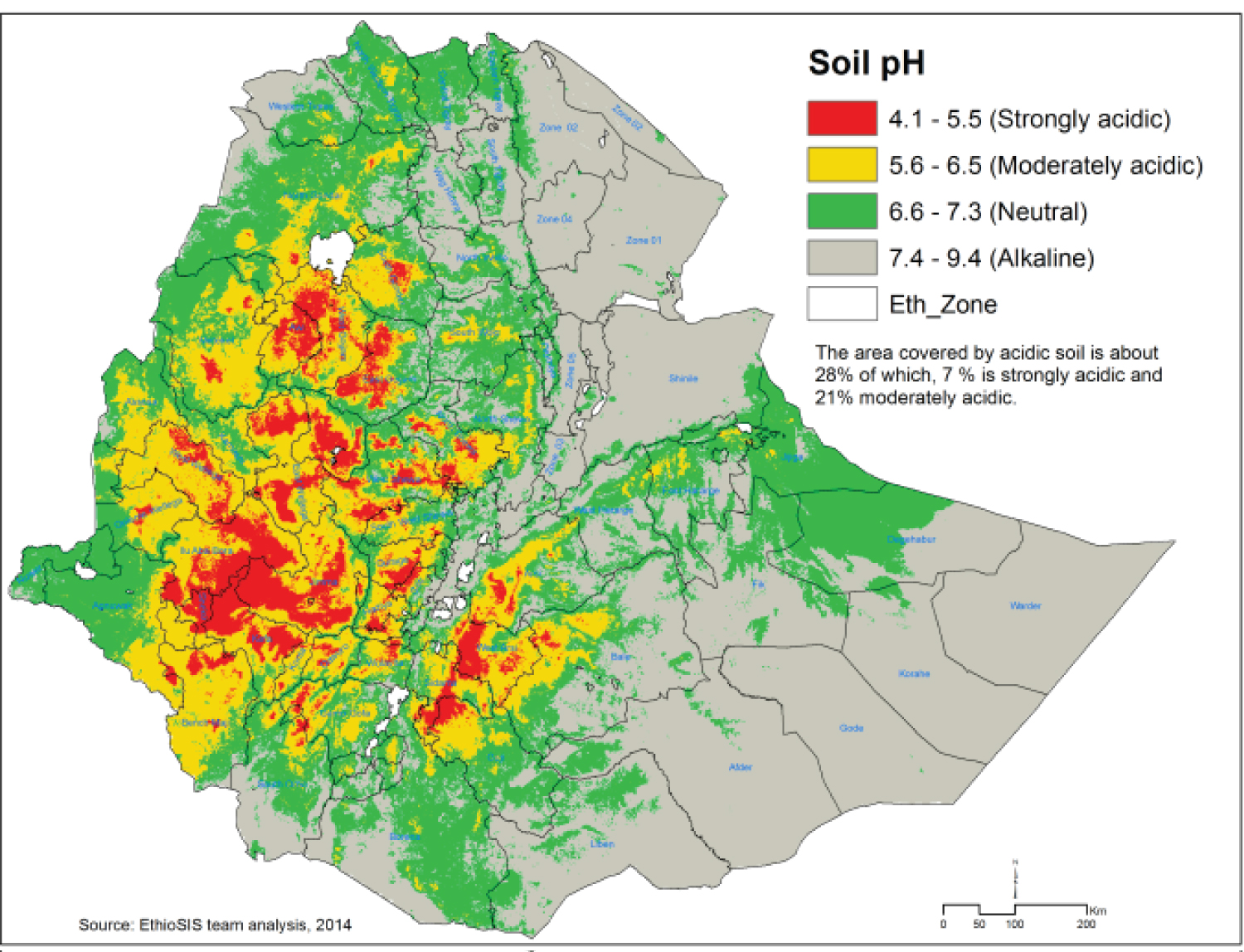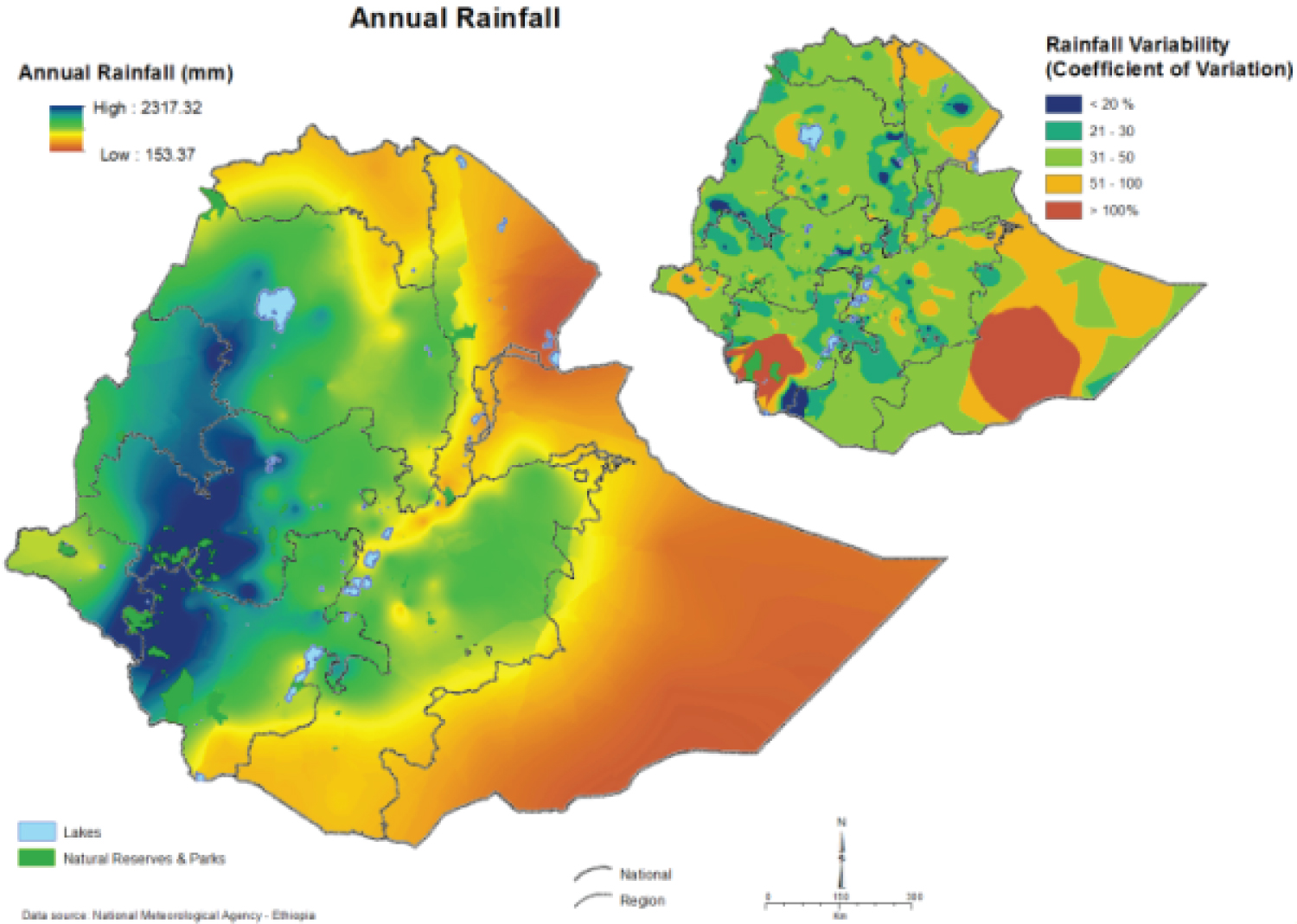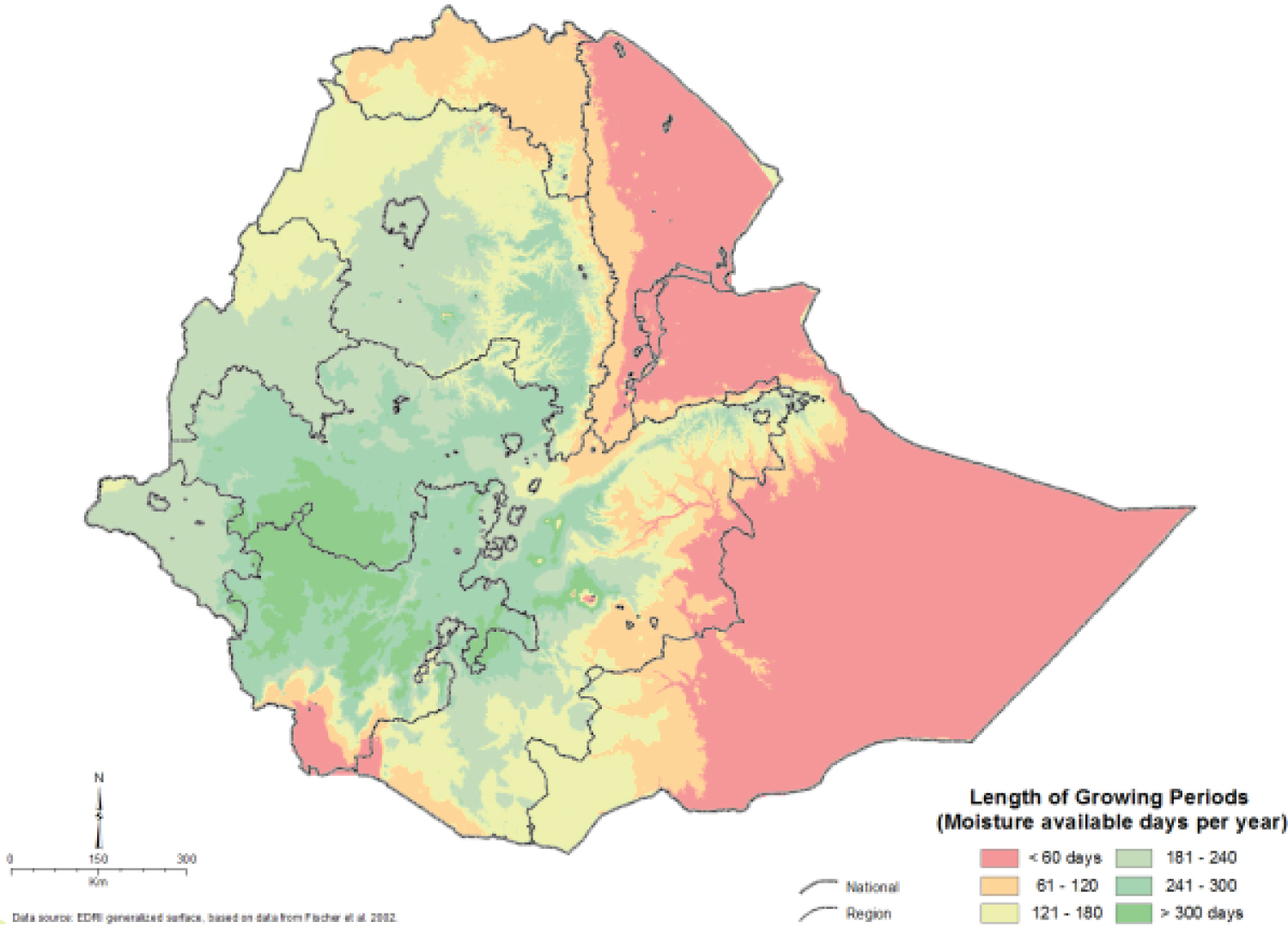Ten Pillars to Determine Sustainable Agricultural Productivity and Livelihood Improvement in Ethiopia: A Commentary Note to Policymakers and Practitioners
Abstract
Ethiopian agriculture is constrained by different factors such as severe land degradation and nutrient depletion, poor soil fertility, crop residue removal, rain-fed farming system, low input, and low output (productivity). Low agricultural productivity is attributed to limited access by smallholder farmers to agricultural inputs, financial services, improved production technologies, access to extension packages, irrigation, disconnected agricultural markets; lack of diversified productions; and more importantly, to poor land management practices (i.e., inefficient agronomic practice) that has led to severe land degradation. Though soil-water conservation is getting attention in recent years, after a large amount of soil nutrients and natural forests are degraded and deforested, land degradation is still the biggest threat. Land degradation is further exacerbated by free-and-overgrazing, deforestation, population pressure, inadequate land use planning (i.e., without planning what suits what types of land use and why), insufficient enabling policy and financial support from financial institutions, and unequal extension visit and package access to both gender groups. Therefore, to reverse such impacts and causes of low productivity, ten main factors (pillars) are identified from the literature and recommended for further considerations by policymakers, practitioners as well as researchers. These pillars are believed in enhancing maximum productivity and improving livelihoods of the smallholders of Ethiopian farmers by renovating subsistence and traditional farming systems.
Keywords
Ten Productivity Pillars, Land Suitability, Sustainable Agriculture, Livelihood Improvement, Ethiopia
Introduction
Agriculture plays an important role in the Ethiopian economy for long centuries. This sector accommodates around 80% of rural population of the country, which supports about 45% of the GDP [1] and supplies about 70% of the country's raw material to secondary activities [1,2]. That is, agriculture influences the path of the economy both in terms of its impact on the overall output and on employment. About 11.8 million smallholder households account for approximately 95% of agricultural GDP and 85% of employment [3]. About 25% of rural households earn some income from non-farm enterprises, but less than 3% rely exclusively on income from such enterprises. Nearly, 55% of all smallholder farmers operate on one hectare or less [4]. Ethiopian agriculture has showed the most rapid growth in its history during the past recent decade, mainly cereal production increased by 54.9%, with more than 10% annual average growth rate [5]. It is considerable growth in agricultural production in terms of area cultivated and volume of crops production [6]. However, average crop productivity still remained as low as 2.05 MT per hectare for major cereal crops [3]. And food security remains a critical issue for many rural households and for the country as a whole. Moreover, expansion of the cropped area to more marginal lands has led to severe land degradation and nutrient depletion [7]. Although cereal crop production has more than doubled over the past decade to more than 350 million quintals [8], as a result of horizontal expansion and increased yields. However, Ethiopia has still tremendous potential for agricultural development. For example, of the total area of 1.13 million km2, about 62% of the land is cultivable (38% cultivated and 24% potential for agriculture) [9].
Ethiopia's agriculture sector is constrained by a range of factors. In this paper, the main factors (pillars), which affect agricultural production and productivity, are assessed and presented. These factors are believed in contributing to the transformation of Ethiopian as well as African agriculture and food security, within a sustainable context in reducing hunger and poverty so that sustainable productivity and livelihood improvement will be achieved. One of the major factors to be managed is soil and soil related variables. Soil and soil related challenges are including but not limited to: severe land degradation; nutrient depletion; complete removal of crop residue; fragmented or lack of application of Integrated Soil Fertility Management (ISFM) technology; little or no manure application; imbalanced inorganic fertilizer use; and lack of comprehensive soil fertility information [10]. A number of soil-related activities and programs have been carried out in the past to curb the impacts of such constraints. However, securing updated and accurate soil-related information has remained a challenge. Consequently, scientific analysis has been hindered that could provide strategic information for decision-makers, researchers, practitioners (extension workers), and smallholder farmers. When some agricultural inputs (including land) are constrained, output growth is subject to diminishing marginal returns. There could also be negative effects on the quality of natural resources and on the sustainability of the production process (Lovell, 1993).
The objective of this paper is to identify factors (pillars) affecting land productivity on the ground and forward recommendation for policymakers, researchers, and practitioners so that they will consider such pillars while playing their respective roles to enhance sustainable agricultural productivity and improve livelihoods.
Methodology and Statistical Evidences
Literature review and statistical evidence of spatio-temporal analyses were carried out to understand the past trends. For which, statistical evidence of some factors like improved seed cover, fertilizer cover, cereal areas, and all crop areas by regional and national levels, from national statistical figures, were evaluated for the last five years. After reviewing many works of literatures, ten pillars were identified, which affect agricultural production and productivity. Hence, based on these analyses, a conceptual framework is developed to show the link of ten main pillars and sub pillars, which affect agricultural production and productivity. This communication paper is based on reviewing different literature and analyzing secondary datasets.
Evidence from statistical data
Crop production area: The main area coverage of agricultural production is accounted for 79.3%, 13.4 and 7.3% for cereals, pulses, and oilseed, respectively [11] (Figure 1a), whereas the total cereal production areas of smallholders' Meher season (main growing season), has been increased from 10.9 million hectares of land in 2006 to 13.8 million hectares in 2012 [11,12]. Comparing cash-crops like coffee and other vegetables and root crops production with cereal production areas the former covered small portions of cultivated land. This in turn reflects the farming and feeding systems of the people are not yet developed and diversified. Hence, this requires adopting other countries experience into the system so that rural people can exercise diversified crop production including but not limited to cash-crops (coffee, tea), root crops, perennials, and other types of crop, which can resist the seasonal rainfall variability and climate change challenges, on one hand, and enhance to adopt better feeding system and food and nutrition security for a healthier life; and also market-oriented production for better economic capacity and livelihood improvement, on the other.
Looking at regional disparities of main crops production (cereals) the Oromia region covers large areas and the Amhara region covers the second largest area of cereal production (Figure 1b). This also goes with the size of regional boundaries and the suitability of the area for crop production that the Oromia region covers the largest portion. The next highest proportion of cereal producing region, following Oromia, the Amhara region across the five years' record (2006/7-2010/11). And then Oromia and Amhara regions have relatively high agricultural potential areas in the central parts of the country, which are more suitable for crop production. Other regions have relatively less suitable for cereal crop production. The southern Nations, Nationalities and Peoples Region (SNNPR) is highly dominated with root-crops and vegetables as agroforestry farming system, these crops have a longer history in this region though cereal production is relatively low. Unexpectedly, The Harari region is one of the highest proportional cereals producing areas (Figure 1c) compared to its smallest size but not with its actual production area size. However, Afar and Somali regions recorded less or minimal cultivated land area compared to other regions. These areas are arid and semi-arid zones, which are dominated by livestock rearing than crop production.
Cereal productivity (yield): As it is presented in Figure 1d, the maximum yield recorded from the Maize crop is 31 quintals per ha at the regional level and it is 22 quintals for national record [13], which is the maximum from all main cereal crops. The national average of the five main kinds of cereal is 16 quintals per ha (Figure 1d). Given that Tef is the highly demanded crop in the country. Its national productivity increases from 8.5 quintals in 2006 to 11.5 quintals in 2011, and up to 19 quintals in 2020 at country level [8], but it is still one of the least yields recorded as compared to other cereals.
Fertilizer use: Fertilizer use is one of the modern input technologies applied to increase productivity. In Ethiopia, the application rates, time and, types of fertilizer are not following the recommended ones and are not based on the demands of the cultivated land as well as not crop-specific. Ethiopia used the blanket recommendation of only two types of fertilizers (DAP and Urea) for all types of soil and for all crops for the last 45 years. Even with these two fertilizers, these were used mainly for cereal crops in many parts of the country. Looking at the last five years' fertilizer use, for cereal crops by regional comparison, shows that fertilizer application increases in 2011 as compared to 2006 in all regions [13] (Figure 2). Although fertilizer application is increased by 10% annually for the last ten years, the yield increased only by 5.5% per year [3]. The national average of fertilized area coverage from the last five years was increased 42-58% for cereals production [3]. However, the average rate of fertilizer uses in the country (which is roughly less than 40 kilograms per hectare) remains much lower than elsewhere (e.g., 54 kg/ha in Latin America, 80 kg/ha in South Asia, and 87 kg/ha in Southeast Asia) [14].
Uses of improved cereal seeds: Seed can be found in three types: local variety, hybrid, and genetically modified (GM). The first two seeds are commonly growing in Ethiopia while the third one is not. Nowadays, developed nations commonly use GM seeds to feed their large population within the limited land they have cultivated by increasing productivity (intensive farming). However, in developing countries like Ethiopia, there are still greater potential to increase productivity using local varieties and hybrid seeds of maize, sorghum, wheat, and other cereals before going to GM. Ethiopia has a big capacity to increase its productivity from such seeds by balancing the uses of modern input technologies. One of these technologies is improved seeds (either local varieties and/or hybrids). From the statistics of five years cereal production, uses of improved seeds is not widely practiced, and with an average national rate of 3.5-7.3% [13], (Figure 3). There could be many reasons for this low rate of improved seed applications: This might be due to access, awareness, trust, quality of imporved seeds, among others.
Ten agricultural productivity pillars: A conceptual framework
Among the many and complex factors those affect agricultural production and productivity, the following ten factors (pillars) are identified and believed in narrowing agricultural productivity gaps. These pillars are believed in addressing comprehensive and complex features of land and land resources such as natural, physical (infrastructure), biophysical and socio-economic parameters to achieve sustainable yield in the sector by protecting the environment through soil-water and natural resource conservation actions. One factor doesn't fulfill the expected outcome without the other, and they are interlinked. These pillars can bring large impacts on the sector if they are interactively managed (Figure 4). These ten pillars are categorized into two major components: productivity side and sustainability side. The productivity side contains the first 5 pillars (pillars 1 to 5), which enhance agricultural production and productivity whereas the second group of pillars (pillars 6 to 10) ensure the sustainability of the sector.
Land suitability
Land suitability means its natural capability to support a specific purpose [15]. According to FAO, this is strongly related to the "land qualities" such as resistance to erosion, availability of water, and flood hazard. However, these qualities are derived from the "land characteristics", such as slope and length, rainfall, and soil texture which are confidently measurable. It is advantageous to use these land characteristic values to study the suitability of a given land. Hence, the land characteristic factors were used to work out land suitability for irrigation, rain-fed, crop type, growing period (duration of crop calendar), and/or other similar activities. The suitability of land is assessed considering a rational cropping system, for optimizing the use of a piece of land for a specific use [16]. Hence, a crop's land suitability is a function of crop requirements and land characteristics and it is a measure of how well the qualities of the land unit match the requirements of a particular form of land use and crop type. Generally, land suitability for agricultural production and productivity is an abstraction of many factors: Including elevation, slope (topography), soil type, land use/cover, the biophysical and chemical status of soil, soil moisture retention and permeability, and length of growing periods (LGP) and LGP variability. In reality, the multidimensional and dynamic nature of agricultural potential should be considered when developing more site and condition-specific strategies development [17]. Hence, five types of land suitable classes such as highly suitable, moderately suitable, marginally suitable, currently not suitable, and permanently not suitable [15] were used to evaluate further potentials of an area. Then, each application should first plan and identify the types of land capability and implement accordingly. Otherwise, land use application without analyzing the land suitability results in economic and environmental failures, and resource wastages. In this paper, authors encourage land users to understand land suitability the authors when planning for a specific purpose before being operationalized.
Improved seed varieties
Improved seeds are one of the core pillars of the agricultural inputs. Improved seeds such as local varieties and hybrid ones have been contributing major parts of agricultural yield gap. According to CSA and EDRI (2011), improved cereals' seed application over the last five years (2006/07 to 2010/11) is very low though increases from year to year. The national average area covered with improved cereal seed ranged from 3.5-7.5%; though zonal level area cover varies up to 50% (for example, West Gojjam, West and South West Shewa zones).
At the regional level, Southern Nations, Nationalities and Peoples Region (SNNPR) reached up to 16% cereal area coverage. This figure is not mainly due to the highest area coverage of cereals but the region used relatively better improved seed even it has allocated small areas for cereal crops. Instead, SNNPR is known for its non-cereal crops such as vegetables, fruits, species, and also coffee and tea. However, looking at high cereal-producing parts of the country such as the central highlands of Amhara, Oromia, and Tigray regions, the area for improved cereal seed application is still at the lowest level (Figure 3). Moreover, varieties that are more productive and resilient to climatic stressors are going to be very important under changing climatic conditions. Improved seeds can raise the net maize income by 47-67% [18]. Therefore, developing countries in Africa and elsewhere in the world should not only create appropriate awareness among their smallholder farmers, policymakers, and practitioners but also avail improved seeds with affordable at sufficient amounts at the right time and place.
Fertilizer application
One of the modern agricultural inputs is fertilizer application. It is one of the Ethiopian Government's strategies to boost agricultural production and productivity. Fertilizer use was the most reported input commodity and commonly used for the last five decades. However, looking at statistical figures on fertilizer use and area coverage, its application is still low as compared to the recommended use, rate, time of application and types [5,10,13]. Ethiopia was using only two types of fertilizer (Diammonium-phosphate-DAP and Urea) for the last five decades as a blanket recommendation for all types of agro-ecology and crop types at the national level though the current change of soil test fertilizer recommendations is undergoing [19] for soil-based fertilizer requirement and Ethiopia applies blend fertilizers replacing DAP, which requires a follow-up evaluation. Similarly, other African countries, even East African countries use more than 2 fertilizer types either blended or compound or both types depending on farmers' choice [20]. Nowadays, it is generally accepted that there is a decline in the fertility of agricultural soils throughout the agricultural land of the country. This is due to reduction in the length of fallow periods, lower levels/rates of fertilizer application and/or inappropriate type of fertilizers, completes removal of crop residues from fields (70-90%) and/or burning, use of dung as a household fuel (50-80%), and lack of adequate soil conservation practices [21,22].
National statistical evidence on fertilizer applications for the last 10 years (2003-2013) showed that the uses of two types of fertilizers increased by 10% every year but agricultural production increases only by 5.5% (calculated from CSA's annual report, 2013); that is, production is less than by half though fertilizer use has been increased. The Ethiopian national average area covered by these two types of fertilizers for the last five years' ranges from 42 to 58% [13] though some zones covered up to 90% of their agricultural land (e.g., West Gojjam and Awi zones in Amhara region, Central Tigray zone in Tigray region, West and South West Shewa zones in Oromia region) (Figure 5).
From the current move of the country towards balanced fertilizer, it is not only chemical or compound/blended fertilizers being recommended but also organic fertilizers such as compost, bio-fertilizers, and other types of fertilizers, to be incorporated into the system. Hence, integrated soil fertility management (ISFM) technology packages are the best approach for high soil fertility and showed high performance to narrow agricultural yield gaps [5]. However, Ethiopia realizes that the country requires many types of fertilizers for its diverse agro-ecology and crop types.
By doing its soil test from agricultural land, a soil-test recommendation is developed by the Ethiopian Soil Information System (EthioSIS) project jointly lead by of Agricultural Transformation Agency (ATA) and Ministry of Agriculture (MoA). Accordingly, the country now shifts to using blended or compound balanced fertilizer types based on soil-test results and soil nutrient deficiencies [10]. EthioSIS project has produced and recommended to use more than ten types of fertilizers at the national level based on soil test analysis. This is an exciting move towards food security by improving modern technology inputs into the agricultural sector depending on nutrient deficiency levels of the soil.
However, application rates, balanced types, application timing, and combinations with other land degradation causes (such as acidity, sodicity/salinity) should be fine-tuned at the national level. The management, rates, and type of fertilizer applications are different for high acidic and/or high alkaline soil from that of neutral agricultural soils. For example, if the soil is highly eroded with heavy rainfall, there is a high possibility of soil acidity. Acidic soil management should be done prior to applications of other balanced fertilizers in order to minimize further acidification and depletion of the soil nutrient. According to EthioSIS's preliminary prediction result, 28% of the country is acidic soil especially the southwestern part, of which 7% is strongly acidic (pH < 5.5) and required liming prior to any fertilizer applications (Figure 6). Therefore, further fine-tuning work should be carried out with respective bodies to maximize the benefits of balanced fertilizer and ISFM approaches.
Soil management issues are very important to keep soil fertility status besides applying proper fertilization. Therefore, besides ISFM options, the following few tips are very important for keeping soil fertility such as keeping crop rotation (cultivating with diversified crops from season to season), returning/leaving crop residues to the fields, proper horizontal tillage, controlling erosion, using cover crops whenever possible, returning manures to the soil and adding organic materials are also considered as other means of developing soil nutrients status by improving the biological, physical and chemical properties of the soil.
Moisture availability
Moisture is the other main and very important factor for plant growth and soil fertility. Agricultural yields depend on the length of growing periods (LGP) of a given area; that means how many days of sufficient moisture are available in the soil per year in a given area. Soil moisture is maintained from different sources (rain-fed, surface, and/or groundwater sources). Rain-water is used in two ways: Harvest and rain-fed. Harvesting technology was mobilized in 2008 in most areas of the country, and some areas were benefited from this campaign. However, this was not applied depending of the landscape and real demands of the area and resulted in failures in many parts of the country.
Statistics showed that in 2008, Ethiopia had large area coverage with harvested rain-water for agricultural production; but after this year, the campaign failed since the movement was not site-specific, lack of proper design and application. On the other hand, surface or groundwater is another source of soil moisture, which is regulated and used at a demand base. Irrigation (either drip or furrow) is still at its lowest stage though Ethiopia has 12 river basins with an annual runoff of 122 billion m3 of water and an estimated 2.6-6.5 billion m3 of groundwater potential, relatively large volumes [23]. Rainfall is essential for the non-irrigated agriculture practiced across most of the country. The western highlands have particularly high rainfall, averaging more than 1,200 mm annually in many areas; while the maximum annual rainfall reaches up to 2,317 mm in some parts of the country. However, this surface runoff from rainfall erodes the fertile topsoil and takes to nearby rivers; and this potential is not properly used either at water harvest or irrigation from rivers.
Rainfall is lower with a loss of elevation, especially toward the eastern parts of the country. Most of the eastern lowlands are too dry for any crop production [13]. Though Ethiopia has a large amount of annual rainfall (~1 trillion m3 per year) [24], its spatio-temporal variability is also very high [13], (Figure 7). The coefficient of variation of annual rainfall is calculated for the past 10-58 years. Medium variability is common in the highlands. Rainfall variability (greater than 30% variability) in annual rainfall represents an increased risk for farmers who depend on rainfall for crop production. Afar region experiences little rainfall variability and also low annual rainfall, making that most part of this region is unsuitable for crop production from rain-fed but has a great potential from groundwater and rivers; and less variability shows consistent dryness [13]. Lack of water storage and less amount of annual rainfall is not enough water for most farmers to produce more than one crop calendar per year.
Hence, frequent droughts, and dependency on rain-fed agriculture exacerbate the incidence of crop failures and result in food insecurity and poverty [23]. On the other hand, most parts of the nation's length of growing periods (LGP) are found in a very good status (Figure 8), but still need to integrate with other pillars to have better productivity in areas having relatively good LGP (> 180 days). The LGP refers to the cumulative amount of time during a normal year when moisture conditions are adequate for plant growth. The Food and Agriculture Organization of the United Nations (FAO) defines LGP as the number of days in a year when sufficient water is available in the soil profile to support plant growth [25].
It is based on the number of days with a mean daily temperature above 5 °C and with available water (from precipitation or stored soil moisture) exceeding half the potential evapotranspiration. LGP captures multiple factors (rainfall, potential evapotranspiration, and soil moisture storage properties) that together define the most important dimensions of agricultural potential. Thus, a longer LGP generally indicates higher agricultural potential. It is important to note that the potential for irrigated agriculture is not reflected in the LGP. Even within areas with long growing periods, other characteristics such as steep hillsides or nutrient-poor soils may limit agricultural production.
Both rain-fed and developing irrigation programs and using their resources are believed in maximizing agricultural sectors by giving the chance for water stress areas to become a year-round high production and intensify productivity of a given area. Given the soil moisture available even for the semi-arid, arid, and desert areas, it is evident that the promotion of irrigation at both small and large scales can provide an opportunity to improve the productivity of land and labor and increase production volumes.
Hence, combining these two approaches depending on the suitability of the areas (either irrigation or rain-fed or both), there is high potential for growth and development options through agricultural production and enhance the government strategies in a series of Growth and Transformation Plan (GTP) of the country.
Agronomic practice/crop management
Agronomic practice ranges from farmland preparation to post-harvest loss management. The core activities in this section are farmland preparation, using disease and adverse effect resistant varieties, planting (sowing, row planting, or trans-planting), protection (pesticide, herbicides, weeding, and hoeing), fertilizer applications (type, rate, and time), crop rotation (alternating, intercropping and agroforestry), harvest (cut and carry), straying, transportation of yields, and storage systems. In this junction, we should not forget to apply the certified and approved types of pesticide, herbicide as well as weed-attack chemicals otherwise these chemicals result in production loss (damage, spoil, and also affect ecosystem) rather than increasing productivity. Furthermore, modern agronomic practice/crop management starts from soil fertility status management.
Agricultural yields are affected by processes at every stage of land and crop management but we are not conscious enough to protect the process at every step mentioned above. Hence, serious follow-up and monitoring systems should be acquired by everybody who is engaged in the agricultural sector so that agricultural productivity (yield) can be sustainably increased and also contribute to the industrial successive economy of the nation.
Soil-water and natural resource conservation (SW-NRC)
According to FAO (1983), soil is responsible for 95% of our food production, and yet one-third of our soil on this planet is degraded and not recoverable within a human lifetime. FAO projects a 60% increase in the demand for food by 2050, underlining the need for robust and modernized agricultural systems, which is beginning particularly within the soil layer. That is why the UN declared that 2015 was the year of soils. Looking at the most disaggregated level, soil-water conservation should start at watershed levels. The upper parts (catchments) of watershed areas' soil-water and natural resources conservation have impacts on the lower catchments and the watershed level's production and productivity.
At the watershed level, conservation of natural resources resulted in high production, soil nutrients, avoiding moisture stress, and protecting other biota and ecosystem services. This SW-NRC also contributes to the lower catchment areas by decreasing siltation and flooding, increasing productivity and maintaining soil moisture, and having a continuous flow of streams and rivers. The capacity and exposures of smallholders to implement such SW-NRC initiatives are limited to the extent that they have limited ownership right to manage their watershed. SW-NRC and development programs are promoted for the last decade to the overall economic development in rural areas through optimum utilization of in-situ natural resources to generate employment as well as restoring ecological balance and ecosystems services. Hence, to achieve the best results from SW-NRC, people should be sensitized, empowered, and involved in the various stages of the watershed program from planning, implementation, monitoring, and evaluations of each intervention with the ultimate objectives of sustainability productivity and livelihood improvement.
Access to finance
Finance is one of the bottlenecks and jeopardizes modern agricultural technology packages particularly in developing countries; whose smallholder farmers are following traditional farming systems and subsistence productions. Smallholder farmers, in Ethiopia for example, own less than one hectare of land and produce only to support his/her family, leading subsistence life. Beyond that, these farmers follow the traditional farming system (meaning rain-fed, non-cash-crops for only family consumptions, and non-diversified crops). The agriculture sector is also vulnerable to many factors including climatic, natural, and disease impacts, price fluctuations for inputs and products, or crop failure due to pests and diseases.
However, to participate and use modern agricultural inputs (e.g. fertilizer and improved seeds), maximize yields, and produce marketable surpluses, lack of financial access impaired these farmers besides other factors hindering their commitment to modernizing their farming systems. Hence, setting up rural financial services and access to smallholder farmers should be considered as one factor in the agricultural value chain. This requires addressing both structural and service-quality issues in creating a vibrant and self-sustaining rural financial sector. Strong financial institutions offer access to the rural sector-adapted to credit and related financial services [26]. Therefore, improved financial systems can improve the efficiency of agricultural productivity and its value chains by lowering transaction costs, accessing inputs, and improving local sources for productions and exchanges.
Enabling policies to agriculture and related sectors
This implies that the policy environment in general enhances agricultural production and productivity for both smallholder and/or commercial farmers. These are starting from the availability of infrastructure, market access (linkage), consistent and predictive policy environment at all levels to the development of the sector. In addition, enabling policy is related to input supply policy, monetary and credit policy, land use policy, land tenure/land reform and improvement, market liberalization/trade promotion policies; policies for institutional setup; and readiness/preparedness for natural and induced disasters. Enabling agricultural and related sectors' policies are very crucial for the innovation, development, and expansion of agricultural production and productivity. In Ethiopia, land tenure policy should be looked at different levels and the nature of the community. However, for smallholder farmers in the highlands, where crop production is dominant, land tenure should be suitable for farmers to all kinds of rights that ensure sustainability.
Labor, extension packages and services
Access to labor is one of the main factors affecting productivity. Agriculture by its nature is a labor-intensive sector and requires strict follow-ups and interventions throughout growing periods of each crop's calendar. Although the type of management and frequency varies from crop to crop, generally, it requires day-to-day care and exerting maximum crop management effort to achieve the required yields. The other component besides labor is extension packages and services, which have paramount values on agricultural production and productivity. It enhances and strengthens research-extension-farmer linkages, improve technology generation and use, transfer of knowledge and resources, and utilization and feedback from smallholder farmer to decision-makers at woreda/district or kebele levels (kebele is the lowest administrative levels of Ethiopia). In connection to this, the number of visits by extension workers is also highly relevant to productivity [27].
Market access/accessibility
The term 'accessibility' refers to the distance to a point of interest and the ease with which each destination is reached. Accessibility has been defined as the ability for interactions or contacts with sites of economic or social opportunity [28]. Travel time and destination choice are crucial to the definition of accessibility: The less time required to reach them, and the more numerous and variable spaces of destinations are those could be higher the level of accessibility [29]. Access to the given market was defined using a cost-distance rendering function in which time to access the market is accumulated over a friction surface that considers the road infrastructure, surface slope, and land cover types [5]. Land cover and road network have been classified based on the estimated time taken for a limited speed; while the slope is included as a hindering (speed-reducing) factor (e.g., people walk and cycle more slowly up-hill than flat surfaces) [30].
Market access or infrastructure plays an important role in transportation cost, input supply, and output market. That is, the market linkage on the chains of agricultural inputs (fertilizer, improved seeds, extension packages, and services), and output supply to the market are depending on the available infrastructure (road network and quality, transport, and time to reach nearest big marketplace), and supply chains (systems). Market access is indispensable for sustainable food supply from smallholders as well as from big investment programs. Hence, if the market is accessible to smallholder farmers, agricultural production and productivity are profitable and sustainable, provide a reasonable price for end-users as well as producers can buy inputs easily, thereby improving the livelihoods of the citizens.
Conclusion
As agriculture is still the backbone of the economy, it should have especial attention from all actors to improve its production and productivity. However, agriculture is not only dependent on rain-fed but also affected by recurrent drought and global climate changes; which results in low agricultural production and productivity, and then low socio-economic development. On the other hand, with the continues demand for more agricultural productions for consumptions and industrial inputs, Ethiopian agriculture should need a paradigm shift from rain-fed to irrigation by strengthening soil-water conservation activities those foster in producing more and diverse commodities by withstanding weather variability (climate changes). Irrigation practice has many advantages over rain-fed: It resists short-term weather/climate anomalies, allows repeated productions in one calendar year, is suitable to use different advanced technologies for agricultural inputs, etc. Hence, it has the potential to improve agricultural productivity by having access to water/moisture even during dry spells and then lengthening growing periods.
Even though there are different constraints for the agricultural sector, there are also multitude of opportunities for agricultural production systems as the country is endowed with different agro-ecologies. These diversified aspects of the country would be important areas to implement the country's investment policy directions, and advance our agricultural productions systems at the national and/or regional levels depending upon their agro-ecological requirements. In this line, further studies are recommended to have a site and/or commodity-specific analyses. Site-specific and well-managed interactions of these ten pillars are playing key roles to overcome major challenges we face today such as population pressure, climate change (or variability), soil erosion, land degradation, low agricultural productivity, and food insecurity. Decision-makers, researchers, and practitioners at all levels of the value chain are advised to take these ten pillars into consideration as a tool for sustainable agricultural development and livelihood improvement of the people who are directly or indirectly involved in the sector. Furthermore, these pillars are also helping the country to achieve sustainable natural resource management and combat climate change through integrated approaches.
References
- EthioSIS (2014) Ethiopian soil information system, Team Analyses, Addis Ababa. Ministry of Finance and Economic Development (MoFED) and central statistical Authority (CSA), 2009. Five-year National Statistical Development Strategy (NSDS) (2009/10- 2013/14).
- (2011) Federal democratic republic of Ethiopia country strategy Paper 2011-2015. African Development Bank (AfDB).
- (2013) Report on area and production of major crops (private peasant holdings, Meher Season). Agricultural sample survey, volume I. Central Statistical Agency (CSA).
- (2014) Report on area and production of major crops (private peasant holdings, Meher Season). Central Statistical Agency (CSA). Agricultural sample survey.
- Schmidt E, Kedir M (2009) Urbanization and spatial connectivity in Ethiopia: Urban growth analysis using GIS. IFPRI: 35.
- Seyoum A, Dorosh P, Asrat S (2011) Crop Production in Ethiopia: Regional Patterns and Trends. Development Strategy and Governance Division, International Food Policy Research Institute, Ethiopia Strategy Support Program II, working paper 0016. Ethiopia.
- (2010) Ethiopia’s agricultural sector policy and investment framework (PIF) 2010-2020. MoARD.
- (2020) Report on area and production of major crops (private peasant holdings, Meher Season). Central Statistical Agency (CSA). Agricultural Sample Survey.
- Shiferaw H, Kidanu S (2013) Agricultural land map of Ethiopia. A working report, Ethiopian. Agricultural Transformation Agency (ATA). Unpublished Report.
- EthioSIS (2014) Preliminary prediction result of acidic soils of Ethiopia. Ethiopian Soil Information System (EthioSIS) project. Ministry of Agriculture (MoA) and Agricultural Transformation Agency (ATA).
- (2012) Report on area and production of major crops (private peasant holdings, Meher Season). Agricultural sample survey, Ababa, Ethiopia. Central Statistical Agency (CSA).
- (2006) Report on land utilization (private peasant holdings, Meher Season). Agricultural sample survey, Ababa, Ethiopia. Central Statistical Agency (CSA).
- CSA, EDRI (2011) Atlas agricultural statistics 2006/07-2010/11. Unpublished report of Central Statistics, Addis Ababa, Ethiopia.
- (2015) Assessment of fertilizer consumption and use by crop in Ethiopia. IFDC: 23.
- (1976) A framework for land evaluation. FAO Soils Bulletin 32.
- Kassawmar T, Zeleke G, Bantider A, et al. (2018) A synoptic land change assessment of Ethiopia's Rainfed Agricultural Area for evidence-based agricultural ecosystem management. Heliyon 11: e0914.
- Pender J, Place F, Ehui S (1999) Strategies for sustainable agricultural development in the East African highlands. International Food Policy Research Institute.
- CIMMYT (2014) Sustainable agricultural intensification in Ethiopia: Achieving maximum impact through adoption of suites of technologies. SOCIOECONOMICS PROGRAM.
- (2017) Soil Test Fertilizer recommendation for Different Regional States in Ethiopia. Ethiopian Agricultural Transformation Agency, Addis Ababa, Ethiopia. Agricultural Transformation Agency (ATA).
- (2015) URL1: AfricaFertilizer.org, accessed.
- Bojo J, Cassels D (1995) Land degradation and rehabilitation in Ethiopia: A reassessment. AFTES Working Paper No. 17. World Bank, Washington DC.
- Yirga C, RM Hassan (2010) Social Costs and incentives for optimal control of soil nutrient depletion in the central highland of Ethiopia. Agricultural system 103: 153-160.
- Awulachew SB, Yilma AD, Loulseged M, et al. (2007) Water resources and irrigation development in Ethiopia. Colombo, Sri Lanka: International Water Management Institute: 78.
- Awulachew SB (2010) Irrigation potential in Ethiopia: Constraints and opportunities for enhancing the system. International Water Management Institute (IWMI).
- (1983) Guidelines: Land evaluation for rain-fed agriculture, FAO Soils Bulletin 52. FAO.
- (2014) Rural Financial Services project. Ethiopian Agricultural Transformation Agency (ATA).
- Bart M, Engida E (2013) Mobile services and market information. IFPRI.
- Deichmann U (1997) Accessibility Indicators in GIS. Department for Economic and Social Information and Policy Analysis. United Nations Statistics Division: 24.
- Handy SL, Niemeier DA (1997) Measuring accessibility: An exploration of issues and alternatives. Environment and Planning 29: 1175-1194.
- Pozzi F, Robinson T (2008) Accessibility mapping in the horn of Africa: Applications for Livestock Policy, IGAD LPI: 11-08.
Corresponding Author
Hailu Shiferaw, Research Fellow, Water and Land Resource Center, Addis Ababa University, P.O.Box 7985 Addis Ababa, Ethiopia
Copyright
© 2021 Shiferaw H, et al. This is an open-access article distributed under the terms of the Creative Commons Attribution License, which permits unrestricted use, distribution, and reproduction in any medium, provided the original author and source are credited.

